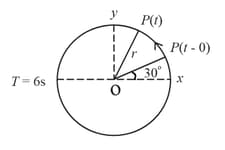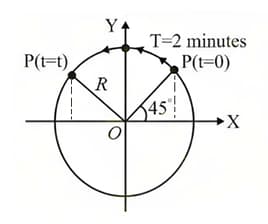Simple Harmonic Motion as a Projection of Uniform Circular Motion
Simple Harmonic Motion as a Projection of Uniform Circular Motion: Overview
In this topic, we will try to visualise the simple harmonic motion as a projection of uniform circular motion. Furthermore, we will discuss some real-life examples that describe this concept in detail.
Important Questions on Simple Harmonic Motion as a Projection of Uniform Circular Motion
For particle revolving round the centre with radius of circular path and regular velocity , as shown in below figure, the projection of on the -axis at time is

Using the reference circle, derive the expression of the particle executing SHM.
Explain the relationship between uniform circular motion and SHM.
A particle is undergoing SHM according to the equation . Plot the corresponding reference circle.
Suppose a particle P is moving uniformly on a circle of radius A with the angular speed . The sense of rotation is anticlockwise. If the , it makes an angle of with the positive direction of the x-axis. In time , it will cover a further angle .What is the projection of position vector on the X-axis at time .
If we tie a stone to the end of a string and move it with a constant angular speed in a horizontal plane about fixed point, the stone would perform a :
If the particle is moving in circular motion under SHM, then its x-projection is depending upon
The x-projection for a certain particle in circular motion under SHM with period of , amplitude of oscillation is and initial phase of is
Which of the following conditions is not sufficient for S.H.M. and why?
Two particles are performing simple harmonic motion in a straight line about the same equilibrium point. The amplitude and time period for both particles are same and equal to and , respectively. At time one particle has displacement while the other one has displacement and they are moving towards each other. If they cross each other at time , then is:
In the given figure it corresponds to a circular motion. The radius of the circle, the period of revolution, the initial position, and the sense of revolution (i.e. clockwise or anti-clockwise) are indicated on figure?

Obtain the corresponding simple harmonic motions of the x-projection of the radius vector of the revolving particle P.
Plot the corresponding reference circle for simple harmonic motion. Indicate the initial position of the particle, the radius of the circle, and the angular speed of the rotating particle. For simplicity, the sense of rotation may be fixed to be anticlockwise in every case: (x is in and t is in ).
In the given figure it corresponds to circular motions. The radius of the circle, the period of revolution, the initial position, and the sense of revolution (i.e. clockwise or anti-clockwise) are indicated on the figure?

Obtain the corresponding simple harmonic motions of the x-projection of the radius vector of the revolving particle P.
Explain Simple harmonic motion in terms of reference circle.
Explain reference circle of simple harmonic motion.
A particle is in a uniform circular motion around origin. What is the angle made by the position vector of the particle with the X-axis, when its displacement along the X-axis becomes half the maximum displacement?
A particle P is moving on a circular path of radius as shown in figure. If time period is , then the equation of projection on y axis for particle P is (where is in seconds)

A particle is moving in a uniform circular motion on a horizontal surface. Particle's position and velocity at time are shown in the figure in the coordinate system. Which of the indicated variable on the vertical axis is/are correctly matched by the graph(s) shown alongside for particle's motion?

A stone is swinging in a horizontal circle in diameter, at . A distant light causes a shadow of the stone to be formed on a nearby wall. What is the amplitude of the motion of the shadow? What is the frequency?
A particle is moving in a uniform circular motion on a horizontal surface. Particle position and velocity at time are shown in the figure in the coordinate system. Which of the indicated variable on the vertical axis is incorrectly matched by the graph shown alongside for particle's motion-

